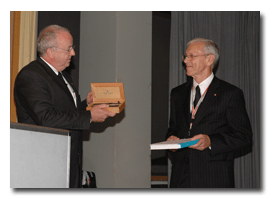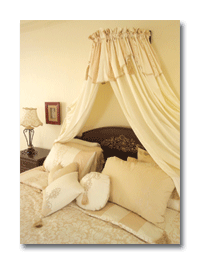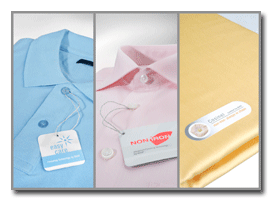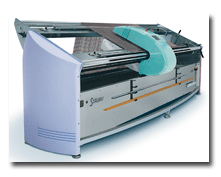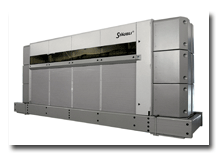T
he 250th Then-Airflow machine manufactured by Germany-based Then Maschinen GmbH since the
company’s relaunch was recently supplied to Austria-based Huber Tricot GmbH. During a small
celebration, Then presented Huber Tricot with a commemorative plaque to mark the special occasion.
Huber Tricot, part of Austria-based Huber Holding AG, knits and finishes top-quality
products for in-house requirements and a sales collection. The most important company brands are
Huber, Hanro of Switzerland and Skiny.
Company Overview
Huber Tricot was founded in 1908.
Since 1968, production has been centered in Mäder, near the border with Switzerland. Today, Huber
Tricot employs 290 in knitting, finishing, cutting and prototype sewing shops.
Huber Holding employs approximately 800 people. Following a slump from 1999 to 2002, Huber
family members and financial investors formed a new partnership with 50-percent involvement of a
Chinese/Australian partner, Benger Brands Ltd., Hong Kong, which put the company back on track.
“From 1999 to 2000, we had major problems, and the bottom of the economic trough was
reached,” said Huber Tricot CEO Helmut Schrenk. “In 2002, radical measures were initiated, and the
entire company was restructured. The primary aim was to retain Huber’s traditionally high
standards, and to this end, we installed the first central dyehouse control system from Then.
Success came relatively quickly, and from 2003-04 onwards, we have been in the black, and our
equity ratio currently stands at 42 percent.”
Schrenk also described the restructuring and adjusted use of production capacity as
additional important measures, and these were achieved with the assistance of Karl-Heinz
Überbacher, head of finishing. Until 2002, production was exclusively for in-house consumption
only, but since 2003, a collection has been presented that has attained extremely rapid success. “
Today, we are already selling over 50 percent of our production to third parties, and the trend is
upwards,” Schrenk said. “In this way, we have been able to achieve 100-percent use of production
capacity.”
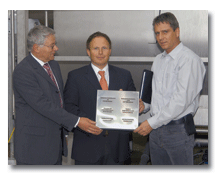
Werner Hübsch (left), sales director, Then Maschinen GmbH, presents Helmut Schrenk, CEO
(center), and Karl-Heinz Überbacher, head of finishing, Huber Tricot GmbH, with a commemorative
plaque to mark the delivery of the 250th Then-Airflow machine.
Quality And Creativity Number
The most important target groups are
comprised of first-class make-up companies around the world. In view of the battle for market
share, Schrenk sees just one possibility: “We seek to serve our global customers with excellent
quality and market-compatible prices. This is the only method of creating long-term chances in this
tough market.”
Schrenk stresses his pride in working with a good team that pulls together. He sees a
leading role for Huber Tricot in the natural-fiber segment. The company mainly uses natural-fiber
yarns made of cotton, wool, silk and, as an exclusive feature, a blend of silk with elastane.
In order to be on pace in a creative sense, the company has its own development department
with a staff of four. Close contacts with fiber manufacturers and customers, and visits to trade
fairs, including Expofil in Paris, also provide further inputs for the development of new and
fashionable qualities. The company regards the focal points of the future as consisting of the
continued development of products of the highest quality with fine gauges, in combination with
mercerized articles.
Markets
Output in the three-shift operation
amounts to 2,000 metric tons per year, which adds up to some 11 million meters of open and tubular
goods. The export quota is high and on the increase, with the most important markets currently
being Japan, Great Britain, Germany, Switzerland, Belgium and the United States. Huber is the
supplier for a range of well-known labels in the high-price segment. The global market/sales unit
consists of both Huber staff and local representatives. During the last year, group sales amounted
to around 90 million euros.
Schrenk describes the protected Smooth Skin quality, a particularly fine finished fabric, as
being a sales program hit. As demonstrated by Überbacher using various washing samples, even after
30 to 50 washes, the product looks like new and shows no sign of pilling. “This process was
developed on our Then-Airflow machines,” Überbacher said.
Schrenk is satisfied with the current market situation but added: “There is stiff, predatory
competition, and a company like Huber can only be successful through first-class quality and
perfect service, which enables us to face up to the big producers. We do not sell via price, and
our customers are satisfied when they receive top standards. We also supply small quantities such
as 2.5 kilograms of goods for collars.”
Machine Pool
Huber uses only German and Swiss
machinery, including seven Then-Airflow AFA units all controlled by the TDS System. The TDS assumes
the administration and organization of the dyehouse and integrates both Then and other product
makes, PC control systems and hosts to form a complete system. This includes order supply,
disposition, recipe systems and calculation programs for the optimization of dyeing processes. The
linkage of the various parts of the dyehouse is guaranteed by an optimum data flow and a clearly
structured and flexible production sequence. Production data input takes place centrally.
The order for three Then-Airflow AFA units included the 250th machine to be produced by Then
since the company restart. “The jubilee machine is one of an order of three, and naturally we are
satisfied — otherwise we would not buy any more Then-Airflow equipment,” Überbacher said. “In
addition, the complete process control system with TDS functions perfectly, and amortization will
take just two years.” Huber Tricot and Then have been cooperating successfully for many years, and,
according to Überbacher, the first prototype machines were the result of joint development
work.
November/December 2006


